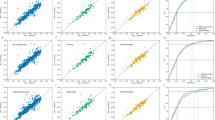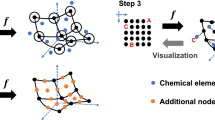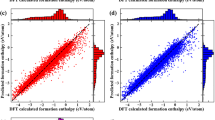Abstract
IN comparing my arithmetical table1 with his adaptation of Mendeleef's short chart, A. A. Clifford2 states that a Periodic Table must show the variation in the properties of the elements with atomic number. This is an argument against short charts3, because they fail to retain beyond the third period the continuous variation of properties from active metal to active non-metal. Vertical relationships between the elements are very strong at the extreme right of the arithmetical table; traversing towards the left they weaken, and when the transitional elements are reached horizontal as well as vertical relationships are apparent; still farther to the left, horizontal relationships are most marked4. Other tables do not exhibit this important change in direction and strength of the chemical relationships.
This is a preview of subscription content, access via your institution
Access options
Subscribe to this journal
Receive 51 print issues and online access
$199.00 per year
only $3.90 per issue
Buy this article
- Purchase on SpringerLink
- Instant access to full article PDF
Prices may be subject to local taxes which are calculated during checkout
Similar content being viewed by others
References
Simmons, L. M., J. Chem. Educ., 25, 658 (1948).
Clifford, A. A., Nature, 184, 2012 (1959).
Luder, W. F., J. Chem. Educ., 20, 21 (1943).
Simmons, L. M., J. Chem. Educ., 24, 588 (1947).
For example, Werner, A., Ber. deutsch. chem. Ges., 38, 914 (1905). Foster, Laurence S., J. Chem. Educ., 23, 602 (1946).
Quam, G. N., and Quam, Mary Battell, J. Chem. Educ., 11, 28 (1934).
For example, Pauling, L., “General Chemistry” (Freeman and Co., San Francisco, 1953). Moeller, Therald, “Inorganic Chemistry” (John Wiley and Sons, Inc., New York, 1952). Sienko, Mitchell J., and Plane, Robert A., “Chemistry” (McGraw-Hill Book Co., Inc., New York, 1957). Cranston, John A., “Rational Approach to Chemical Principles” (Blackie and Son, Ltd., London, 1955). Simmons, L. M., “A Comprehensive Text Book of Inorganic Chemistry” (Wm. Brooks, Sydney, 1957).
Author information
Authors and Affiliations
Rights and permissions
About this article
Cite this article
SIMMONS, L. Periodic Classification of Elements. Nature 186, 154 (1960). https://doi.org/10.1038/186154a0
Issue date:
DOI: https://doi.org/10.1038/186154a0



